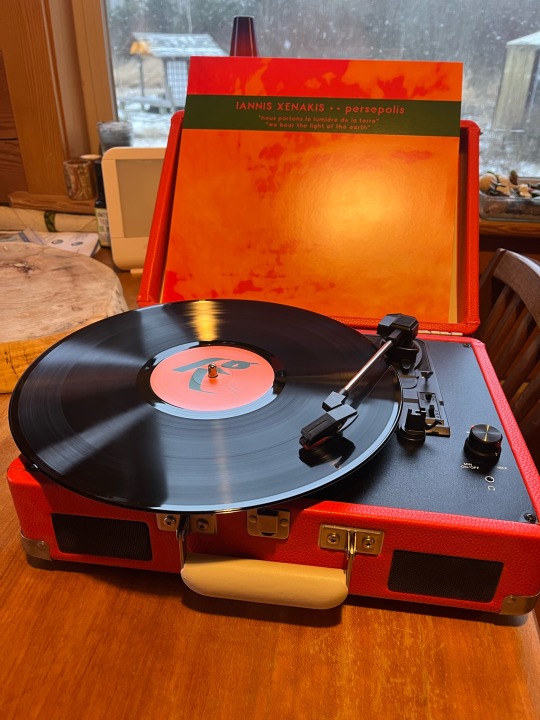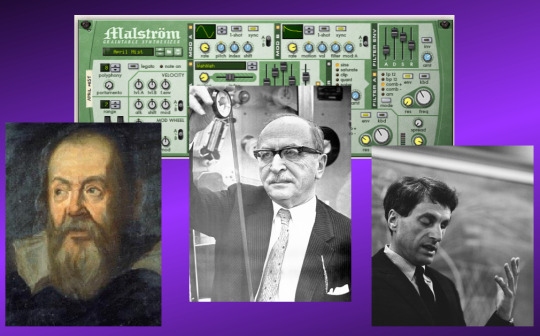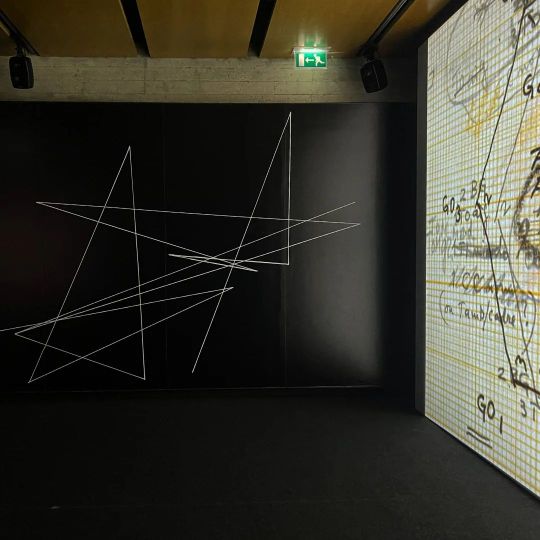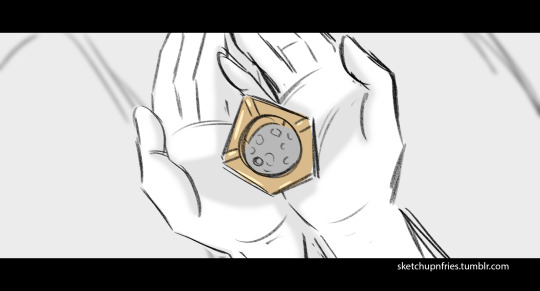#xenakis
Quote
Art, and above all, music has a fundamental function, which is to catalyze the sublimation that it can bring about through all means of expression. It must aim through fixations which are landmarks to draw towards a total exaltation in which the individual mingles, losing his consciousness in a truth immediate, rare, enormous, and perfect. If a work of art succeeds in this undertaking even for a single moment, it attains its goal. This tremendous truth is not made of objects, emotions, or sensations; it is beyond these, as Beethoven's Seventh Symphony is beyond music. This is why art can lead to realms that religion still occupies for some people.
Iannis Xenakis, Formalized Music
192 notes
·
View notes
Photo

#dearcharlesedouard #xenakis #pansdeverreondulatoires https://www.instagram.com/p/CjROO9ZNdzO/?igshid=NGJjMDIxMWI=
35 notes
·
View notes
Video
youtube
00:00:00 - "Hanging Gardens"- The Necks
00:57:43 - "Lonh, For Soprano & Electronics" - Kaija Saariaho
01:12:43 - "Mahakala Sadhana/Dagkye" - David Lewiston
01:38:33 - "Peaux" - Les Percussions De Strasbourg / Xenakis
01:49:10 - "Figure Out" - Massacre
02:14:27 - "Les Fleurs du Mal" - Biosphere
02:25:11 - "Contemplation Part.1" - Fred Gianelli
02:52:43 - "Der Pendler" - Fritz Hauser
03:05:15 - "Saturn" - John Coltrane
03:16:47 - "Consume Red" - Ground-Zero
04:13:45 - "Le Drame de la Vie" - Valère Novarina
04:17:56 / END
Mixed by Dj Bouto
#ambient #contemporary #trance
#the necks#kaija saariaho#david lewiston#xenakis#massacre#biosphere#fred gianelli#fritz hauser#john coltrane#ground-zero#valère novarina#ambient#contemporary#trance
3 notes
·
View notes
Text


15 notes
·
View notes
Text

A Short History of Granular Synthesis – Part 1
When we look at the way how granular sound processors, namely granular synthesis VSTs and other granular sound processing software, are used, we might think this technique is practised either by quite old so called “serious” electronic musicians, or by quite young artists and producers, who are interested in spectacular effects generated with free granular synths, or with expensive graintable synthesizers, doing granular sampling, or using hardware granular synths. Either way it looks like being a quite young approach to working with sound. Being asked my oldest grandson told me that it was – maybe – 10 years ago, when musicians started to process sound on a granular basis, whereas one of my sons-in-law thought to know it better, when he claimed, that it was in the 1940s, when someone – he didn´t know the name – started using granular techniques with sound.
Both were terribly wrong – and so was I before I started preparing for this book. (see also “In the World of Grains” here: https://www.dev.rofilm-media.net/node/332 )
The idea of understanding sound as a more or less organised aggregation of short grains was firstly uttered by the Dutch philosopher and scientist Isaac Beeckman in the first decade of the 17th century, more than 400 years ago!
But without the technical requirements and conditions to make musical use of the idea, all thoughts and thinking about a possibly granular structure of sound vanished into oblivion for more than 330 years.
It wasn´t a musician nor a philosopher who revived the notion of sound as a cluster of grains – probably without knowing about Beeckman at all.
During the first half of the 20th century the development of the quantum theory gained speed. Leading physicists like Max Planck, Niels Bohr, Werner Heisenberg and others smashed the notion of things like time and space as a continuum, and proved, that time, space and even reality as a whole has a corned, a grained, a granular structure, with these “corns”, these “grains” called “quanta”. Quantum physics was the new rock´n´roll of the scientists.
And therefore it might not be that astonishing, that – in 1946 - it was the physicist and mathematician Dennis Gabor, who came up with what would lead to the modern granular processing of sound of today.
He even constructed a number of electro-mechanical machines producing “quanta of sound”, as he called them. These machines were huge “monsters” reminding of cinematographs.
But his most important contribution to the further development of working with grains of sound was his research concerning the influence of the length of a grain and the frequency of its content on how the human ear conceives them. These researches laid the ground for bringing the matter from the realm of physics to the area of art and music.
Still – it would last 13 more years (1959/1960) before grains appeared in a piece of musical art, and it was the Greek composer Iannis Xenakis, who let the world hear the first composition, which was – partly – based on granular techniques: Analogique A-B.
Without going into too many details here in this short brief, there shall be mentioned the following at least: Xenakis recorded a string orchestra, cut the tape into certain tiny parts, rearranged them, glued the snippets together again, added the sound from electronic tone generators to the rearranged snippets, and re-rcorded the whole thing. Then he let the orchetra play a small part of the previously recorded piece. Then the orchestra stops playing and gets a musical answer from the tape. The answers from the – let me call it – composed grains get more and more perfect. It seems, that the tape sound undergoes a kind of learning process. Then both, the acoustical instruments as well as the tape, the grains and the electronically produced sounds play together.
Imagine, what an immense amount of working hours and how detailed a compositional plan it will have needed to work with tape snippets of grain lengths in such a manner!
Later – in 1971 – Xenakis published “Formalized Music”, a book in which he layed out a musical theory of how to compose using grains of sound.
But in the meantime – between 1960 and 1971 – some other interesting things happened. Things, which would accelerate the development of granular sound machines and software.
… to be continued.
or you might like to visit our Facebook group https://www.facebook.com/groups/rofilmmedia
#grains#granular#granularsynthesis#granularsoundprocessing#sonicgrains#noise#experimental#electronicmusic#experimentalmusic#Xenakis#Beeckman#IsaacBeeckman
2 notes
·
View notes
Photo

Xenakis's work is an alien shard , glimmering in the heart of the West . Iannis Xenakis - Persepolis ( 1LP ) #iannisxenakis #xenakis #persepolis #experimental #soundart #classical #avantgarde #20thcentury #noise #electroacoustic #musiqueconcrete #abstract #album #lp #records #vinyl #vinylgram #vinylcollection #vinylpassion #vinyldigger #vinylhunter #vinylcommunity #vinyladdict #vinyljunkie #vinyloftheday #レコード #レコードのある生活 #レコードのある暮らし #レコード好きな人と繋がりたい https://www.instagram.com/p/ChO4I6hPkDJ/?igshid=NGJjMDIxMWI=
#iannisxenakis#xenakis#persepolis#experimental#soundart#classical#avantgarde#20thcentury#noise#electroacoustic#musiqueconcrete#abstract#album#lp#records#vinyl#vinylgram#vinylcollection#vinylpassion#vinyldigger#vinylhunter#vinylcommunity#vinyladdict#vinyljunkie#vinyloftheday#レコード#レコードのある生活#レコードのある暮らし#レコード好きな人と繋がりたい
5 notes
·
View notes
Photo

Latergramming. #xenakis #algorithmicart #gulbenkian https://www.instagram.com/p/Cma8mnoDtop/?igshid=NGJjMDIxMWI=
1 note
·
View note
Photo

ABSTRACT BBO2210AA 80X80 #contemporaryart #philippemanson #abstractart #acrylicpainting #acrylicartwork #xenakis #persepolis https://www.instagram.com/p/CkQ4-h0IATR/?igshid=NGJjMDIxMWI=
1 note
·
View note
Text

Yannis Xenakis’ Polytopes: Cosmogonies in Sound and Architecture
The Polytope of Persepolis took place in the ruins of the Temple of Darius in the Iranian desert on August 26, 1971. The performance, which lasted for over an hour starting at sunset, put together a variety of sound and light devices. It included 2 lasers, military searchlights, huge bonfires, 150 torch-bearing children and six listening stations provided with eight speakers, one for each track of Xenakis’ electroacoustic composition Persépolis. The audience could walk through the temple ruins and move from one listening station to the other.
447 notes
·
View notes
Text

Iannis Xenakis - Formalized Music. Thought and mathematics in composition
212 notes
·
View notes
Text
















Cyberpunk 2077: Phantom Liberty
› Faces of Night City [6/?]
#cyberpunk 2077#johnny silverhand#judy alvarez#song so mi#solomon reed#alena xenakis#kurt hansen#rosalind myers#mr. hands#evelyn parker#jackie welles#aurore cassel#rogue amendiares#male v#oc: ian#aymeric cassel#cp2077edit#faces of night city#gamingedit#gamingnetwork#dailygaming#game photography#virtual photography#cp2077 kdval
216 notes
·
View notes
Text








Some Cyberpunk 2077: Phantom Liberty inspired storyboards of the adventures of my V, Ned "V" Dubois. He faced a lot of stuff that was too much for him to handle
#fanart#cyberpunk 2077#cyberpunk 2077 phantom liberty#phantom liberty#storyboard#storyboards#V#cp2077#v cyberpunk#Ned#ned dubois#solomon reed#alena xenakis#phantom liberty spoilers#spoilers#songbird cyberpunk#song so mi
237 notes
·
View notes
Text


you ever saw a woman so beautiful you cried? ♥︎
#cyberpunk 2077#cyberpunk 2077 photomode#cyberpunk screenshots#cyberpunkedit#cyberpunk aesthetic#cp77#cp77edit#gamingedit#dailygaming#virtual photography#gaming photography#alena xenakis#phantom liberty: alex#my screenshots#breezy's queue#i love her i love her i love her i love h-
89 notes
·
View notes
Video
youtube
00:00:00 - "Pearls And Transformation"- Arcana
00:15:57 - "Night Lights-Density" - Otomo Yoshihide New Jazz Quintet
00:34:41 - "Love Chant" - Charles Mingus
00:49:28 - "Dastgah-E Shur" - Daryoush Tala'i
01:15:11 - "1 May 24, 1972, Paris, Part.1" - Terry Riley
01:40:02 - "D'ore et d'espace #8" - Denys Vinzant
01:49:48 - "Claviers" - Les Percussions De Strasbourg / Xenakis
02:00:05 - "Polypoly" - Arne Nordheim
02:21:43 - "Elektrostatik" - Plastikman
02:31:24 - "Électro chocs" - Jean Genet
02:31:37 - "Piano, Bass, Drums" - The Necks
03:24:58 - "All" - TV Victor
04:20:16 / END
Mixed by Dj Bouto
# : indie, jazz, impro, rock, experimental, ambient, electronica, dUb, transe, psychedelic
#arcana#otomo yoshihide#charles mingus#daryoush tala'i#terry riley#denys vinzant#xenakis#arne nordheim#plastikman#jean genet#the necks#tv victor#indie#jazz#impro#rock#dub#trance
2 notes
·
View notes
Text







Reed and Alex were tired of her in about...5 minutes.
#cyberpunk 2077#phantom liberty#cyberpunk 2077 v#fem v#nomad v#solomon reed#alena xenakis#my screenshots#oc:wren
88 notes
·
View notes
Text

A Short History of Granular Synthesis – Part 1
When we look at the way how granular sound processors, namely granular synthesis VSTs and other granular sound processing software, are used, we might think this technique is practised either by quite old so called “serious” electronic musicians, or by quite young artists and producers, who are interested in spectacular effects generated with free granular synths, or with expensive graintable synthesizers, doing granular sampling, or using hardware granular synths. Either way it looks like being a quite young approach to working with sound. Being asked my oldest grandson told me that it was – maybe – 10 years ago, when musicians started to process sound on a granular basis, whereas one of my sons-in-law thought to know it better, when he claimed, that it was in the 1940s, when someone – he didn´t know the name – started using granular techniques with sound.
Both were terribly wrong – and so was I before I started preparing for this book. (see also “In the World of Grains” here: https://www.dev.rofilm-media.net/node/332 )
The idea of understanding sound as a more or less organised aggregation of short grains was firstly uttered by the Dutch philosopher and scientist Isaac Beeckman in the first decade of the 17th century, more than 400 years ago!
But without the technical requirements and conditions to make musical use of the idea, all thoughts and thinking about a possibly granular structure of sound vanished into oblivion for more than 330 years.
It wasn´t a musician nor a philosopher who revived the notion of sound as a cluster of grains – probably without knowing about Beeckman at all.
During the first half of the 20th century the development of the quantum theory gained speed. Leading physicists like Max Planck, Niels Bohr, Werner Heisenberg and others smashed the notion of things like time and space as a continuum, and proved, that time, space and even reality as a whole has a corned, a grained, a granular structure, with these “corns”, these “grains” called “quanta”. Quantum physics was the new rock´n´roll of the scientists.
And therefore it might not be that astonishing, that – in 1946 - it was the physicist and mathematician Dennis Gabor, who came up with what would lead to the modern granular processing of sound of today.
He even constructed a number of electro-mechanical machines producing “quanta of sound”, as he called them. These machines were huge “monsters” reminding of cinematographs.
But his most important contribution to the further development of working with grains of sound was his research concerning the influence of the length of a grain and the frequency of its content on how the human ear conceives them. These researches laid the ground for bringing the matter from the realm of physics to the area of art and music.
Still – it would last 13 more years (1959/1960) before grains appeared in a piece of musical art, and it was the Greek composer Iannis Xenakis, who let the world hear the first composition, which was – partly – based on granular techniques: Analogique A-B.
Without going into too many details here in this short brief, there shall be mentioned the following at least: Xenakis recorded a string orchestra, cut the tape into certain tiny parts, rearranged them, glued the snippets together again, added the sound from electronic tone generators to the rearranged snippets, and re-rcorded the whole thing. Then he let the orchetra play a small part of the previously recorded piece. Then the orchestra stops playing and gets a musical answer from the tape. The answers from the – let me call it – composed grains get more and more perfect. It seems, that the tape sound undergoes a kind of learning process. Then both, the acoustical instruments as well as the tape, the grains and the electronically produced sounds play together.
Imagine, what an immense amount of working hours and how detailed a compositional plan it will have needed to work with tape snippets of grain lengths in such a manner!
Later – in 1971 – Xenakis published “Formalized Music”, a book in which he layed out a musical theory of how to compose using grains of sound.
But in the meantime – between 1960 and 1971 – some other interesting things happened. Things, which would accelerate the development of granular sound machines and software.
… to be continued.
read more about sonic grains here: "In the World of Grains": https://www.dev.rofilm-media.net/node/332
or you might like to visit our Facebook group https://www.facebook.com/groups/rofilmmedia
#grains#granular#granularsynthesis#granularsoundprocessing#sonicgrains#noise#experimental#electronicmusic#experimentalmusic#Xenakis#Beeckman#IsaacBeeckman
1 note
·
View note